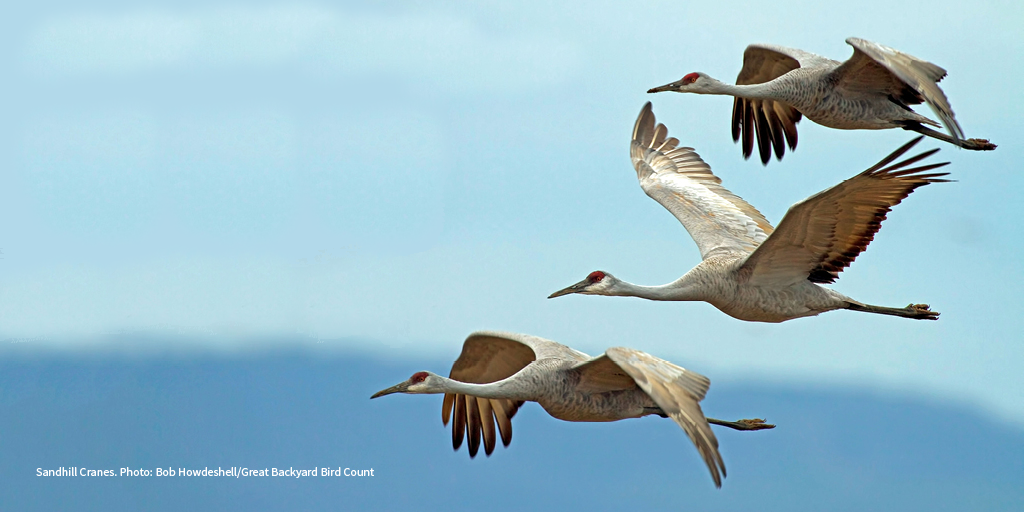The Bird Is The Word

This weekend we celebrated International Migratory Bird Day – a chance to celebrate an amazing diversity of birds, some of which travel incredible distances just to reach their breeding grounds in the Arctic. Were you out birding with the rest of America this weekend?
Birding, or birdwatching, is exactly what you would think…the recreational watching of birds. Fair enough – but why do we dedicate a day just to celebrate an animal that spends a decent part of its life racking up frequent flyer miles? The answer is simple – there are a million reasons to celebrate them. And what you might not know is that birding is a surprisingly popular recreational endeavor – some 18 million “away-from-home birders” and 41 million “around-the-home birders” enjoy it.[i]
Every five years, the U.S. Fish and Wildlife Service puts out a survey report on hunting, fishing and wildlife-associated recreation. Helpfully, every report then spawns an addendum focused on, you guessed it, birding. And guess what? People LOVE birds. Take Alaska, for instance. Participation rates in birding vary across the country, but in general the highest rates were found in more northern states (Vermont and Wisconsin were ranked first and second, respectively), with Alaska coming in at No. 5. Approximately 30 percent of Alaska residents surveyed identified themselves as participating in birding activities.
The economics of outdoor recreation (Outdoor Industry Association)
There is also an economic aspect to birding. The recreation economy is a multi-billion dollar business – the Outdoor Industry Association estimates outdoor recreation generates around $880 billion in consumer spending per year – and from travel expenses to binoculars, cameras, camping equipment and more, expenditures related to birding ripple throughout local economies across the country. The most recent figures showed that birders can spend an estimated $15 billion on trips and $26 billion on equipment in just one year.
The point of all this, of course, comes back to Migratory Bird Day. Birds are remarkable. Not only are they a subgroup of reptiles, but they are the last living examples of dinosaurs! Birds come in every single size, color and shape you can imagine. Supporting the birds that we enjoy across the country means protecting their breeding grounds, especially in the Arctic.
Arctic Tern (U.S. Fish and Wildlife Service)
Take the arctic tern, which has the longest yearly migration of any animal from start to finish. From their Arctic breeding grounds to Antarctica and back, that’s a distance of at least 25,000 miles. They often will return to the very same area where they hatched to breed.
Tundra Swan (U.S. Fish and Wildlife Service)
Tundra swan leave their wintering grounds on the east coast and travel the Atlantic Flyway northwest to breeding grounds in the Arctic. Tundra swans mate for life, usually finding a mate by the time they are 2–3 years old. These beautiful birds are nicknamed the “whistling swan” because of the sound its wings make when flying.
Pacific Black Brant (Ingrid Taylar)
Pacific brant spend their winters in coastal areas along the west coast of the United States, from southcentral Alaska to Mexico. Then in late spring, as their Arctic breeding grounds begin to melt, they head north along the Pacific Flyway – sometimes at altitudes of several thousand feet. Fun fact: brant mate for life, and the family usually stays together through the juveniles’ first winter and spring migrations north.
Semipalmated Sandpiper (Fyn Kynd)
Or there’s the semipalmated sandpiper, a mouthful of a name for a bird that can fit in the palm of your hand. (The term “semipalmated” refers to slight webbing between the toes, only noticeable at extremely close range.) They ae found along the Arctic tundra in summer, before heading south to winter in South America. Research has shown that these amazing little birds can fly nearly 2,000 miles nonstop, and feeding stops during migration can attract thousands of semipalmated sandpipers at once.
Each fall, millions of birds like these flock from the coastal plains of the Arctic National Wildlife Refuge and National Petroleum Reserve-Alaska to our backyards, parks and wildlife refuges. The Arctic Refuge is one of our nation’s most majestic places, home to nearly 200 species of migratory birds that migrate to six continents and all 50 states. Birds from all four flyways in North America, plus several international flyways, migrate to the Reserve every year to raise their young. Even shorebirds from as far away as Hawaii and New Zealand find their way north to the Reserve.
Snow Geese (Bradley Davis)
Protecting places like the Arctic Refuge and Reserve from resource extraction and development isn’t simply an Alaska issue – these faraway places are connected to all of us in many ways, including the migratory birds that depend on them.
[i] To be counted as an away-from-home birder in this study, an individual must have taken a trip one mile or more from home for the primary purpose of observing birds. To be counted as an around-the-home birder in this study, an individual must have closely observed or tried to identify birds around the home. Birding in the United States; A Demographic and Economic Analysis.
Sign our petition and tell your senators to defend the Arctic National Wildlife Refuge from oil drilling.







